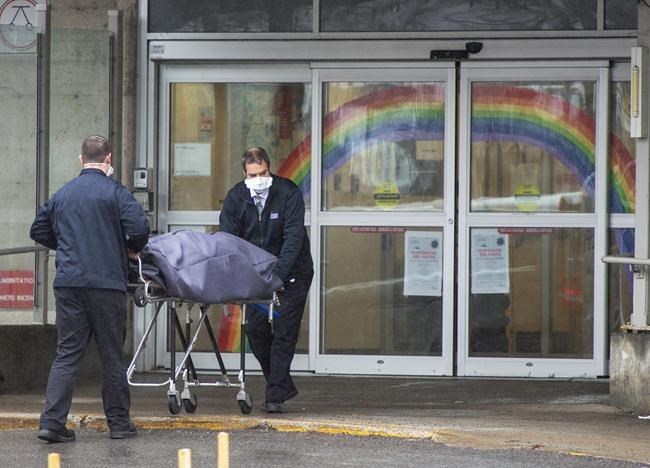
Funeral home workers remove a body from the Centre d'hebergement Ste-Dorothée in Laval, Que., on April 13, 2020. Quebec long-term care home where 100 resident died was not sufficiently equipped to care for patients, the assistant head nurse told a coroner's inquiry on Wednesday. Agnieska Mroz told coroner Géhane Kamel the "red zone" set up in a common room at the CHSLD Ste-Dorothée with what they had available during the second half of March 2020. THE CANADIAN PRESS/Ryan Remiorz
June 16, 2021 - 2:34 PM
MONTREAL - A makeshift quarantine zone set up at a Quebec long-term care home where more than 100 residents died was not sufficiently equipped to care for patients, the assistant head nurse told a coroner's inquiry on Wednesday.
Agnieska Mroz told coroner Géhane Kamel the "red zone" with room for just 20 patients was set up in March 2020 in a common room at the CHSLD Ste-Dorothée, using what staff had available.
There were no oxygen concentrators, key to helping patients in respiratory distress, Mroz said. In emergencies, it was necessary to call a doctor who wasn't on site, so treatments were approved over the phone based on a nurse's observations.
The room contained no bathroom and no running water, she added. For residents who couldn't be washed with wet cloths, hot water had to be fetched from the kitchen in a green zone. There were also no call bells for residents to signal when they needed help.
The quarantine ward failed to control the spread of the virus, and its roughly 20 beds became obsolete in early April when 105 residents tested positive for COVID-19 in a mass testing operation.
On Tuesday, the inquiry heard the long-term care home was beset with COVID-19 infections among managers and staff alike. And because test samples were analyzed in Winnipeg at the beginning of the pandemic and long-term care homes were not considered a priority, authorities at the home reported delays in screening.
The first positive test result arrived on March 26, 2020. By March 28, there were six confirmed infections, and on April 3, the number had jumped to 105.
Mroz recounted that even in the most serious cases, "everyone had to stay at the residence." The Health Department's instructions were not to tie up hospital beds.
"I witnessed a situation where the patient was in quite serious condition," she said, describing a resident who was having difficulty breathing and was in "a very agitated state." She the family's request for a transfer to hospital was denied by the head of the unit. In desperation, “the family themselves called 911,” Mroz added, and paramedics transported the patient to hospital.
Kamel is tasked with investigating the deaths of elderly or vulnerable people in residential settings during the first wave of COVID-19 in Quebec and coming up with recommendations to prevent a recurrence.
This report by The Canadian Press was first published June 16, 2021.
———
This story was produced with the financial assistance of the Facebook and Canadian Press News Fellowship.
News from © The Canadian Press, 2021